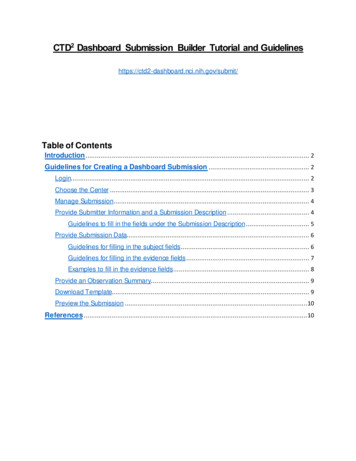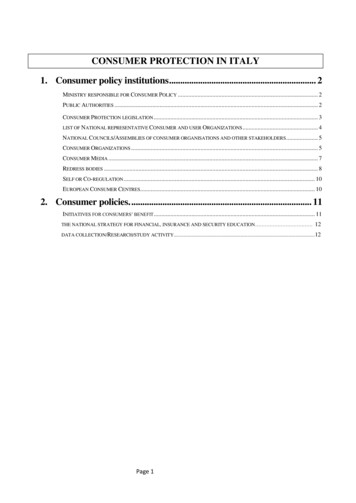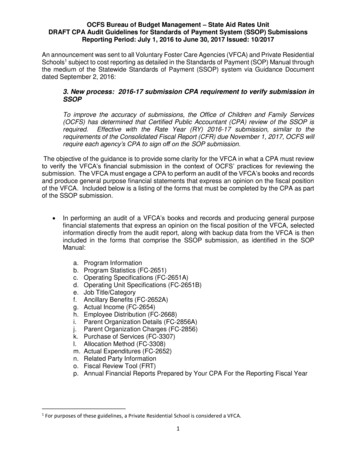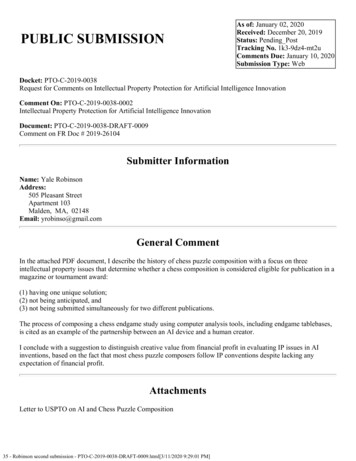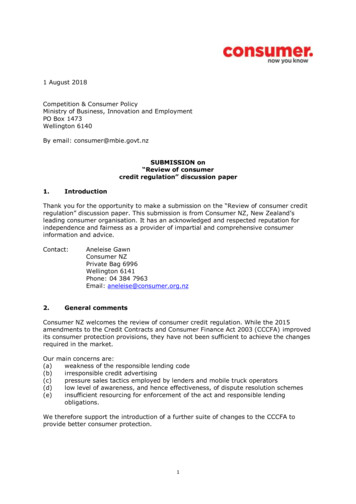
Transcription
1 August 2018Competition & Consumer PolicyMinistry of Business, Innovation and EmploymentPO Box 1473Wellington 6140By email: consumer@mbie.govt.nzSUBMISSION on“Review of consumercredit regulation” discussion paper1.IntroductionThank you for the opportunity to make a submission on the “Review of consumer creditregulation” discussion paper. This submission is from Consumer NZ, New Zealand’sleading consumer organisation. It has an acknowledged and respected reputation forindependence and fairness as a provider of impartial and comprehensive consumerinformation and advice.Contact:2.Aneleise GawnConsumer NZPrivate Bag 6996Wellington 6141Phone: 04 384 7963Email: aneleise@consumer.org.nzGeneral commentsConsumer NZ welcomes the review of consumer credit regulation. While the 2015amendments to the Credit Contracts and Consumer Finance Act 2003 (CCCFA) improvedits consumer protection provisions, they have not been sufficient to achieve the changesrequired in the market.Our main concerns are:(a)weakness of the responsible lending code(b)irresponsible credit advertising(c)pressure sales tactics employed by lenders and mobile truck operators(d)low level of awareness, and hence effectiveness, of dispute resolution schemes(e)insufficient resourcing for enforcement of the act and responsible lendingobligations.We therefore support the introduction of a further suite of changes to the CCCFA toprovide better consumer protection.1
3.Answers to questionsOur answers to specific questions in the discussion paper are set out in the attacheddocument.Thank you for the opportunity to make a submission on the discussion paper. If yourequire any further information, please do not hesitate to contact me.Yours sincerelySue ChetwinChief Executive2
Q1. Do you agree that the problems identified with high-cost lending (evenwhere it is compliant with the CCCFA) are significant? Do you have anyinformation or data that sheds light on their frequency and severity?Yes, we agree the problems identified with high-cost lending are significant.Our 2017 consumer issues survey found 23 percent of consumers were experiencingfinancial difficulties meeting day-to-day living costs and 16 percent were very concernedabout their level of household debt.1To make ends meet: 16 percent of consumers had lived off a credit card until pay day nine percent had missed paying a bill by the due date two percent had missed a mortgage or rent payment.Our 2018 electricity survey also found eight percent of consumers had taken out a loanto pay their power bill.2The financial difficulties these households face in meeting living costs make themvulnerable to exploitation by lenders charging high interest and fees. The CCCFA offerslimited protection for consumers from these practices, effectively tolerating conditionswhere this type of lending can occur.Recent complaints to our office highlight problems that are occurring in the market. In one case, a consumer borrowed 300 from a pay-day lender. She was beingcharged interest on the debt of 584 percent per annum. In a second case, a consumer had fallen behind on payments to a pay-day lender.The lender attempted to deduct nearly 500 per fortnight from her wages torepay a 1900 debt. The consumer had not consented to the deductions andcould not afford the repayments.Q5. Which interest rate cap options, if any, would you prefer? Which interestrate options would you not support? Please explain how you made yourassessment.Evidence from the UK shows intervening to cap high-cost credit has delivered consumerbenefits.The UK’s Financial Conduct Authority (FCA) has significantly strengthened regulation ofhigh-cost short term credit by introducing a suite of reforms including a cap of 0.8percent interest per day, a limit on default fees of 15 and a limit on fees and interest ofno more than 100 percent of the cost of the credit.3The FCA has reported these regulations have brought about substantial changes forconsumers including a: 12reduction in the overall cost of a typical loandramatic reduction in default rates on loansdecline in the number of debt problems.4Nationally representative survey of 1022 New Zealanders, aged 18 and over, carried out in December 2017.Nationally representative survey of 1525 New Zealanders, aged 18 and over, carried out in May t-short-term-credit.pdf3
According to the FCA, the interest cap has led to 760,000 borrowers saving a total of 150 million per year. Notably, it reports consumers who were turned down for high-costcredit generally did not turn to other forms of high-cost or illegal lending.Research published in 2012 by the US-based Pew Charitable Trusts also found benefitsfor consumers from regulating high-cost credit. The report concluded:In states that enact strong legal protections, the result is a large netdecrease in payday loan usage; borrowers are not driven to seekpayday loans online or from other sources Restrictive states eitherdo not permit payday lending or have price caps low enough toeliminate payday lending in the state. This rate cap often is 36percent APR.5Survey research included in the report found 81 percent of borrowersfacing a cash shortfall would cut back on spending if payday loanswere not available.6 The report noted:Even though most borrowers use payday loans for recurring expenses,rather than for emergencies, survey respondents indicated they woulduse a variety of options to deal with those needs if payday loans wereno longer available. In general, borrowers are more likely to chooseoptions—such as adjusting their budgets, delaying bills, selling orpawning personal items, or borrowing from family or friends—that donot connect them to a formal institution.7We consider interventions are required in New Zealand to regulate high-cost credit. Ofthe options proposed in the discussion document, our preference is option C as itprovides better consumer protection.While the discussion document suggests this option may result in illegal lending ordriving lending underground, we’re not aware of robust research showing this wouldoccur.Alongside regulation of pay-day lending, attention needs to be given to improving accessto low-cost financial assistance for low-income consumers who may not be seen as agood credit risk by banks and other mainstream lenders.Q6. If directors have duties to take reasonable steps to ensure that the creditorcomplies with its CCCFA obligations, should any duties apply to seniormanagers?We agree directors should have duties to take reasonable steps to ensure compliancewith the CCCFA. With many small third-tier lenders, it’s likely the company director/s isheavily involved in the firm’s day-to-day management. If this is the case, there may notbe significant benefit in extending the duty to senior managers.Q7. If there are to be more prescriptive requirements for conductingaffordability assessments, what types of lenders or loans should these applyto?567Ibid., p19-20.http://www.pewtrusts.org/ /media/legacy/uploadedfiles/pcs assets/2012/pewpaydaylendingreportpdf.pdfIbid., p16.4
We support more prescriptive requirements for conducting affordability assessments forall types of lenders and loans. This would provide certainty for the market and ensure alevel playing field.Problems are not confined to third tier lenders. Our latest banking survey found 27percent of consumers had received unsolicited offers from their bank in the past year.Offers included credit cards, increases in credit limits, personal loans and mortgage topups.Of those offered a new credit card or an increase in their card limit, only about one inthree thought it suited their needs.Consumer complaints also provide examples of inappropriate credit being offered bybanks.A recent complaint to our office involved a 22-year-old university student who wasoffered a credit card by her bank. The woman had casual part-time employment outsideof study and could have quickly got into financial difficulties if she had accepted thecredit card.In a separate case published by the Banking Ombudsman, a woman struggling to paydebts was offered two unsolicited increases in her credit card limit. The woman hadpreviously approached her bank to consolidate other debts but the bank declined herrequest.8In Australia, there is now a ban on lenders offering unsolicited credit card limit increases.Credit card issuers are prohibited from sending consumers offers to increase their creditlimit without first getting the customer’s agreement.9 This applies to both new andexisting credit cards.The law changes, which took effect from 1 July 2018, mean credit card issuers will notbe allowed to contact consumers in any way (including in writing, by phone or online) tooffer to increase their credit limit, even if the consumer has previously opted to receivethese offers.10The Australian Securities and Investments Commission has also proposed newregulations to ensure consumers are only given credit limits on credit cards that can berepaid within three years.11 We'd like to see similar rules regarding affordabilityintroduced here.Q8. Should there be any change to the requirement that lenders can rely oninformation provided by the borrower unless the lender has reasonable groundsto believe the information is not reliable? What would be the impact of such achange on borrowers, lenders and the credit markets?We’ve previously raised concerns about section 9C(7), which states the lender may basetheir reasonable inquiries on information provided by the borrower unless there aregrounds to believe the information is not reliable.We consider some lenders use this section to limit their inquiries and encourage theborrower to take on debt when it may not be appropriate. We therefore support ts/10115
to this section to minimise the risk of lenders undertaking fewer or less extensiveinquiries to assess affordability.Q9. Do you consider there should be any changes to the current advertisingrequirements in the Responsible Lending Code? If so, what would be the impactof those changes on borrowers, lenders and the credit markets?Yes, we agree changes need to be made to the current advertising requirements in theresponsible lending code.In our view, there has been little change in the advertising practices of lenders since the2015 amendments. We continue to receive complaints about ads promoting credit aseasy to obtain and suitable for non-essential spending, such as overseas holidays (forexamples, see Appendix 1).Other complaints to our office have raised concerns about credit ads that containmisleading information about interest and fees.In one case, a car company advertised finance deals at 3.9 percent interest over 44months. On the basis of the ad and confirmation from the lender of the interest rate, aconsumer purchased a car on finance. He subsequently found he was being charged 3.9percent per annum (not over 44 months), which substantially altered interest payments.Q12. Which options for reducing irresponsible lending and other noncompliance would you support? Which would you not support? Please explainhow you made your assessment.We support the introduction of a creditor licensing system, options proposed forstrengthening enforcement (including penalties for irresponsible lending), and moreprescriptive requirements for affordability and advertising.We also support the extension of risk warnings to a wider range of credit products, a banon advertising of high-cost lending products and disclosure in the same language asadvertising.These changes would result in better consumer protection. We acknowledge there wouldbe some costs to lenders if these options are introduced but do not believe the costswould outweigh the benefits.Q15. Which options for changes to cover additional credit contracts would yousupport? Which would you not support? Please explain how you made yourassessment.We are concerned about instalment payment providers such as Afterpay, Laybuy,Partpay and Oxipay, which may not be adequately covered by the CCCFA. We supportthe inclusion of these types of contracts in the definition of a consumer credit contract.We are also concerned about the practices of mobile traders that are selling over-pricedgoods, charging high fees and trapping consumers in a cycle of debt. We would thereforesupport a prohibition on the price of goods or services sold on credit exceeding the cashprice.In addition, we want to see better protection for consumers who use "Do Not Knock"stickers to warn mobile traders they’re not welcome. We’ve received complaints aboutmobile traders ignoring these stickers. Australia has made it an offence for traders toignore a Do Not Knock sign. Similar consumer protections are required here.6
Q19. Which options for changes to fees regulation would you support? Whichwould you not support? Please explain how you made your assessment.Consumers can face a range of different charges when they enter into a credit contractand the basis for these fees can be difficult to determine. To date, amendments to theCCCFA have failed to assist consumers in identifying what constitutes an unreasonablefee.Given the significant cost of credit fees, we support amendments to specify the feeslenders can charge and improve disclosure of the costs. We support disclosure of anannual percentage rate (APR) that combines interest and fees. Requiring lenders topublish the APR will make it easier for consumers to compare the cost of credit.Q22. What information should be provided to borrowers by debt collectors?When and how should this information be provided?We support requiring lenders to disclose the information set out in paragraph 119(a) to(d) of the discussion paper. We agree this information should be disclosed before takingdebt collection action.Q25. Which options for changes to the regulation of debt collection would yousupport? Which would you not support? Please explain how you made yourassessment.We support the options proposed in the discussion paper. We think a combination ofthese options would provide better protection for vulnerable consumers.Q28. Are there any other issues with the CCCFA or its impact on vulnerablepeople that are not addressed in this discussion paper? If so, what optionsshould MBIE consider to address these issues?Dispute resolution schemes: We've previously commented on the problems forconsumers caused by having four schemes.In Australia, legislation was passed this year to create the Australian FinancialComplaints Authority (AFCA). AFCA will replace the three financial dispute schemes inAustralia. The UK also has a single dispute resolution body, the Financial OmbudsmanService, covering the financial system. We support similar changes here.It is also important dispute resolution processes are transparent. To this end, we believedisputes schemes should be required to publish their decisions. In the UK, the FinancialOmbudsman Service is required to publish all determinations unless there is good reasonfor withholding them.Credit-related insurance: We have significant concerns about sales of insuranceproducts with credit contracts.Consumers may be pressured to buy insurance when taking out credit. For example, inone complaint to our office, a consumer was told payment protection insurance wascompulsory when making a purchase on credit from Smiths City when this was not thecase.In many situations, the cover offered by insurance products may be of poor value andprovide little benefit to the consumer. Mechanical breakdown insurance is one example.The policies can contain long lists of exclusions, stringent service requirements and oftenfail to provide more protection than a consumer has under the Consumer GuaranteesAct.7
We would like to see restrictions in the CCCFA on the sale of these types of productswhen consumers buy on credit.Enforcement: For the legislation to achieve its purpose, effective monitoring andenforcement is required. We believe additional resources need to be made available tothe Commerce Commission to increase market monitoring and ensure consumers canhave confidence lenders are complying with the law.8
Appendix 1: Examples of credit advertising9
10
11
12
13
14
15
payday loans online or from other sources Restrictive states either do not permit payday lending or have price caps low enough to eliminate payday lending in the state. This rate cap often is 36 percent APR.5 Survey research included in the report found 81 percent of borrowers facing a cash shortfall would cut back on spending if payday loans
